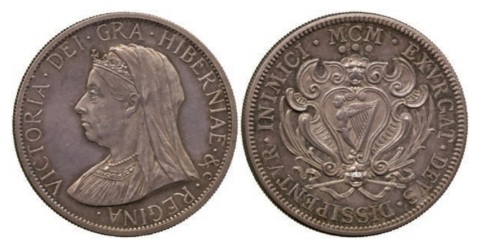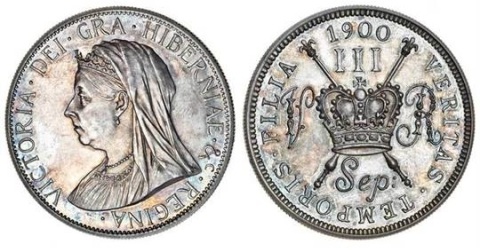Introduction
The rather eccentric Mr Reginald Huth is sometimes described as ‘a gentleman of leisure’ but his actual occupation is not known for certain – the Huth family were best known as financiers in the City of London. According to one source, he was ‘the London representative of the Bank of Spain’ though what he actually did in this role is unclear, since he seems to have been pre-occupied with collecting English, Spanish and Russian coins and medals.
From an Irish numismatic history viewpoint, he is best known for his ‘fantasy patterns’ of 1900 when he commemorated Queen Victoria’s visit to Ireland with a series of unofficial, coin-like issues via a private commission at John Pinches
The Irish Fantasy Patterns of Reginald Huth
Victoria, pattern Double Florin, 1900, struck in silver
- Obverse: older veiled bust left, legend and toothed border surrounding,
- Reverse: struck en médaille, crowned cruciform emblematic shields, garter star at centre, emblems in angles, date either side of top crown, Irish legend, toothed border surrounding,
- Edge: milled,
- 22.54g (D&F 640). Hairlined mainly on obverse, attractively toned, good extremely fine and rare
Victoria, proof pattern Double-Florin, 1900
- Obverse: victoria. dei. gra. hiberniae. &. regina., old veiled bust left, beaded border both sides,
- Reverse: struck en medaille, céad míle fáilte (traditional Gaelic greeting ‘a hundred thousand welcomes’), four crowned shields cruciform, the Irish harp in place of precedence, top and bottom, strings to each harp, shamrocks, rose and thistle in angles, Garter Star in centre,
- Edge: straight grained
- (D&F 641), light tone on lustrous proof surfaces, extremely fine, very rare
Victoria, pattern Three Shillings & Sixpence, 1900, struck in silver
<no image yet>
- (D&F 642)
Victoria, pattern Three Shillings, 1900, struck in silver
- Obverse: older veiled bust left, legend and toothed border surrounding,
- Reverse: struck en médaille, harp at centre of elaborate frame, date in Roman numerals at top, legend and toothed border surrounding,
- Edge: milled,
- 17.06g (D&F 643). Some light raised die flaws on reverse, a little friction to highest points at centre, attractively toned, a pleasing extremely fine and rare
Victoria, pattern Three-Shillings, 1900
- Obverse: victoria. dei. gra. hiberniae. &. regina., veiled head left,
- Reverse: struck en medaille, veritas temporis filia, crown and crossed sceptres dividing ornate V-R, value III above and Sep: below,
- Edge: straight grained
- (D&F 647), brilliant proof surfaces, good extremely fine, extremely rare
Victoria, pattern Three Shillings, September 1900, struck in steel
Struck in steel on a 35.1mm flan, 3.75mm thick, for Reginald Huth by John Pinches. Struck to commemorate Victoria’s visit to Ireland and this piece specifically to Kilrush in Western Ireland on 25th September 1900. This piece is not silver and seems to be made of steel on account of its light weight and magnetism
- Obverse: older veiled bust left, legend and toothed border surrounding
- Reverse: struck en médaille, in the style of James II gunmoney, crown at centre over crossed sceptres, italic V to left, italic R to right, italic Sep: below, III for value above, date at top, value as legend, toothed border surrounding
- Edge: incuse inscription KILRUSH 25: SEP. 1900
- 26.50g (D&F 647)
- Hairlined mainly on obverse, gold test spot at start of legend, otherwise practically as struck and extremely rare
Victoria, pattern Forty-Pence, 1900
- Obverse: victoria. dei. gra. hiberniae. &. regina., veiled head left
- Reverse: struck en medaille, one. sixth. of. a. pound., crown and crossed sceptres dividing ornate V-R, value XL above and Sep: below
- Edge: straight grained
- (D&F 649), brilliant proof surfaces, good extremely fine, very rare
Who was Reginald Huth?
Reginald Huth was born on 11 June 1853 at London and was the son of Charles Frederick Huth and Frances Caroline Marshall. He is listed in Biographical Dictionary of Medallists, Coin, Gem, and Seal-Engravers, Mint Masters, &c., Ancient and Modern with References to their Works, B.C. 500 – A.D. 1900, Volume II, 1904 Biographical Dictionary of Medallists as being an active issuer of private (fantasy) patterns between 1891 and 1904. His reference is as follows :-
a ‘well-known London Collector of Coins and Medals, who has issued, of late years, a number of private Patterns for coins (Pièces de fantaisie) and Medallic Portraits. These pieces, which combine artistic taste in the design and composition with skilful and excellent execution, were struck by Messrs Pinches & Co, London Die-sinkers and Medallists, under the direct supervision of Mr. Huth’
- He married Alice Devaux, daughter of Alexander Devaux, on 30 June 1887.
- He died on 30 November 1926 at the age of 73
Reginald’s father, Charles Frederick Huth was the eldest son of merchant banker Johann Freidrich Andreas Huth (1777 – 1864). He was born in Spain but moved to London in 1809. There, he married Frances Caroline Marshall (died 1901) in 1836 and they lived in Tunbridge Wells, in Kent
- Charles Frederick Huth was an art collector with a particular interest in British watercolours
- His collection was sold at Christie’s on 19 March 1904
- Huth’s younger brother, Louis Huth (1821-1905), was also an art collector
- His son Reginald Huth (1853 – 1926) was the London representative of the Bank of Spain
- Reginald Huth was a keen collector of English, Spanish and Russian coins and medals
- Most notably, he suffered from a severe mysophobia, a pathological fear towards germs about germs and cleaned his coins thoroughly before putting them into his cabinets.
- As a result of this ‘cleaning’, they did not fetch good prices at auction (Sotheby’s, 1927)
- He is often used as an example of the dangers of cleaning coins in numismatic articles and books.
- Catalogue of the valuable collection of coins and medals, the property of the late Reginald Huth
- Sotheby & Co, London – 4th to 7th April, 1927 (738 lots)
- First part: English, Scottish, Irish and Colonial coins
- Sotheby & Co, London – 8th April, 1927
- Second part: English Medals (22 pages + 6 plates / 148 lots)
- Sotheby & Co, London – 14th to 17th June, 1927 (? lots)
- Third part: the Greek, Roman & foreign coins & medals
- Sotheby & Co, London – 4th to 7th April, 1927 (738 lots)
- Reginald Huth was a keen collector of English, Spanish and Russian coins and medals
He lived at various addresses in England during his lifetime :-
- He lived in 1861 at St. Marylebone, London, England
- He lived in 1871 at Paddington, London, England
- He lived in 1891 at Walcot, Somerset, England
- He lived in 1901 at 32 Phillimore Gardens, Kensington, London, England
Other patterns for Reginald Huth
Huth was fascinated by deposed queens and princesses including Liliuokalani and her niece Princess Kaiulani, in whose name he created silver Dala and gold 20 Dala fantasy patterns. Other historical figures honored by him were Madagascar’s Queen Ranavalo; Spain’s deposed Isabel II and the Queen Regent Maria Cristina; Infanta of Spain Luisa Fernanda, Duchess of Mompensier; and the youthful King Alfonso XIII. Huth created several patterns for King George V. The death of his own mother was marked by a coin-like medal of 1901.
- GB Silver Pattern Twelve Groats, 1914
- Fantasy pattern for Reginald Huth struck by John Pinches, bare headed and draped bust left
- Spain Alfonso XIII Fantasy copper Specimen Pattern 20 Centimos 1896 SP65 Brown
- Fantasy pattern struck by John Pinches for Reginald Huth
- Spain Isabel II copper Proof Fantasy Pattern 40 Pesetas 1904 PR65 Brown
- Fantasy pattern struck by John Pinches for Reginald Huth
In addition to the above, Huth also had a medallion made in memory of his dead mother, Mrs F.C. Huth

Silver Medal published by Reginald Huth, dated 1882 for Victoria, Mrs C F Huth, 1901, wife of Charles Frederick Huth, merchant and banker
Who are John Pinches & Co?
John Pinches Medallists were founded in or around 1840 by John Pinches (1825-1905), who had learned steel engraving from his mother’s cousin, medallist William Joseph Taylor (beginning when John was 15 years old in 1840, the year the firm determined as its founding)
Three other members of the Pinches family were associated with the firm after the first John Pinches:
- John Harvey Pinches (1852-1941), the son of the founder.
- John Robert Pinches (1884-1968), a grandson
- A second John Harvey Pinches (1916-2007), a great-grandson
- commissioned into the Duke of Wellington’s Regiment, but was transferred to the Royal Engineers
- served in North Africa, Palestine, Greece and Italy
- won the Military Cross at Salerno on 22 September 1943
- This (second) John Harvey Pinches continued to run the family medallion business, whose output included badges and insignia in Britain, commemorative issues for much of the Commonwealth, and decorations and orders for overseas governments until he sold the business to the Franklin Mint in 1969
- He later wrote the book “Medals by John Pinches; A Catalog of Works Struck by the Company from 1840 to 1969” (Published: 1987)
- commissioned into the Duke of Wellington’s Regiment, but was transferred to the Royal Engineers
A number of 19th C medals or medallions by John Pinches are owned by the British National Portrait Gallery. The ‘not so famous’ second issue of Puffin coins of Lundy Island were struck by Pinches & Co in 1965.
In 1965, a second issue of coins, made by John Pinches, was carried out. These were a commemorative issue to commemorate the 40th anniversary of Martin Coles Harman’s purchase of Lundy. The coins are of the same design as the 1929 issue coins, but have plain edges and the 1965 date.
- They were struck in Proof sets, in bronze, nickel-brass, and gold.
- They were issued in a special case of which at least two varieties exist.
- 3000 of the base metal sets were issued and 25 of the gold sets.
- Unlike the 1929 Lundy issues, which did circulate, these are generally not considered numismatic items
In 1969, Pinches & Co was sold to the Franklin Mint, of Media, Pennsylvania
- The Franklin Mint continued to use the name Pinches on some of their popular numismatic ‘souvenir’ products
- For this reason, most medallions issued in the name of John Pinches from 1969 onwards are quite common, and are more ‘commercial’ in their nature than those produced previously by the independent John Pinches









I’m writing a paper on Huth and the Pinches Co. May I ask where you found all your information on them?
LikeLike
A variety of sources – mostly online and on digitised books.
I’m not doing an academic study, so I have been a bit lazy re citations.
LikeLike